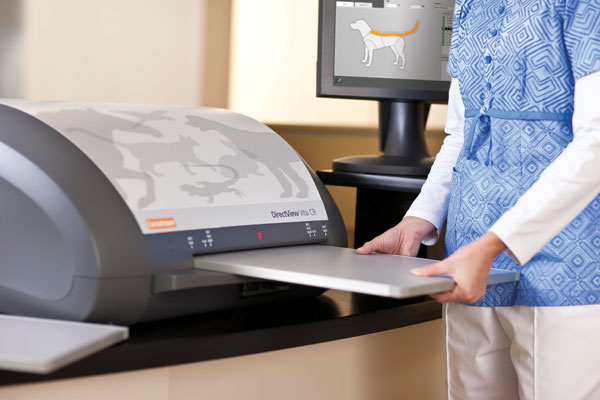
Computed radiography systems, or CR systems, have become a common sight in many medical practices and doctor’s offices because they are a cost-effective, smaller-scale option for conducting X-rays on patients. However, with a piece of equipment this complex, there are bound to be a few questions before your office considers purchasing a CR system.
Whereas traditional radiography uses film to create the image, computed radiography (CR) uses photostimulable phosphor built into an imaging plate. This imaging plate, encased in a cassette, is placed underneath the body part or object under examination and then the x-ray is taken. Where traditional radiography involves developing exposed film in a darkroom, a CR x-ray machine is significantly faster and cleaner. The imaging plate is simply run through a CR reader, and the resulting digital image can be viewed. This can be a huge factor in purchasing a CR system.
While both CR and direct radiography (DR) produce a digital image using a medium based on X-rays, CR uses a housing cassette for its imaging plate, much like traditional film-screen systems, while DR lacks the cassette, directly capturing the image on a flat panel detector. This makes DR systems noticeably less bulky than systems used for CR X-ray machine.
There are different CR systems for different needs. If your office does a small volume of patients then you may be able to obtain an adequate low volume CR system for under $30,000, as compared to the $150,000 alternative of a portable direct radiography (DR) system, the other option for flexibility in X-ray exposures. As an example of volume grades, the Carestream CR classifies a mid-range patient volume as up to 69 exposures per hour.
Absolutely, it is a leading reason for purchasing a CR system. A good CR system can be retrofitted to work in an existing exam room while still offering greater flexibility and ease of use. Because the images resulting from the exposure are entirely digital, the unit can be shared between multiple exam rooms using a single X-ray generator.
There are plenty of benefits, but a few of the leading benefits include the fact that CR systems require fewer retakes, resulting in lower dose to the patient, and faster image development (digital exposures can be ready in 15 seconds), which can result in quicker diagnosis and treatment. Furthermore, images can be easily transmitted electronically to off-site specialists for review purposes.
The digital nature of the exposure can result in greater clarity in reading, and images can be digitally enhanced to assist the medical professional in interpretation. However, it’s been noted that CR exposures overall aren’t quite as crisp as X-rays taken by traditional means, which could make a difference depending on your practice’s particular field of medicine.
While the technology might seem new to you, CR systems have been used for more than 20 years in large-scale facilities throughout the world, so there are plenty of companies offering various buying options. Carestream and Fuji make the two leading CR systems, with the Fuji CR system offering a slightly greater range of volume versus portability. This can be a major factor of CR X-ray machine prices.
CR systems overall are more environmentally friendly than traditional radiography practices, due to the lack of film and chemicals required to process an exposure as well as the reduction of film storage and waste from discarded films (because CR images can be stored digitally).
As stated earlier, the cassette used to house the imaging plate is considered a disadvantage when compared to DR due to its larger size, although many professionals think that it also offers more flexibility for patient positioning. Unfortunately, imaging plates can be quite expensive and are easily damaged when a system requires manual handling. A single imaging plate may be used and reused hundreds, if not thousands, of times, but the constant use will eventually result in damage and need for replacement. This is a major deal breaker when you look to purchase a CR system.
Well, that’s for you and your practice to decide. However, with the steady advancement of technology, CR X-ray machines are more affordable and offer a wider range of capability than ever before. Digital editing software can allow physicians to change the contrast, brightness, and zoom of a single exposure instead of taking multiple exposures in the hope of getting enough detail. CR systems are more versatile, more portable, and make patients’ lives easier – from private practice appointments to long hospital stays. And, really, that’s what the medical field is all about: Making patients feel the best they can. A CR system may better help your office or practice do just that while allowing doctors and staff to do their work more efficiently.
1 thoughts on “Top 10 Questions to Ask When Considering Purchasing a CR System”
very interesting topic, great post.